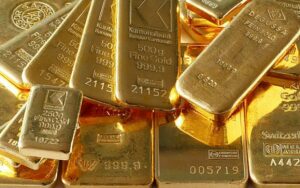Special topics
 Gold futures settled higher Thursday, scoring their best quarterly performance since 1986—a year when “Top Gun” was the most popular movie.
Gold futures settled higher Thursday, scoring their best quarterly performance since 1986—a year when “Top Gun” was the most popular movie.
Bullion has benefited as the Federal Reserve’s dovish stance on policy has softened the highflying U.S. dollar.
June gold GCM6, -0.14% gained $7, or 0.6%, to settle at $1,235.60, after a 0.7% drop on Wednesday.
Prices for the most-active contracts saw a monthly gain of less than 0.1%—the smallest of the year, but gold jumped 16.4% in the first three months of 2016, its strongest quarterly showing since the third quarter of 1986, according to FactSet.
“Gold’s early-year rally began to lose momentum as March wore on, primarily due to profit-taking and a very large accumulation of short positions by the large commercials segment of paper-gold traders on Comex,” said Brien Lundin, editor of Gold Newsletter.
That “massive” commercial short position—a wager that prices will fall—is currently the “primary impediment” for the gold market, he said. Commercial traders use futures to hedge price against risk tied to their businesses.
“If past form holds true, some of the large entities in the commercial category will hit the market hard with sell orders, to drive the price down and collect on their short positions,” said Lundin.
But looking further out into the year ahead, Michael Armbruster, principal and co-founder at Altavest, believes that gold is likely to benefit from some key “tailwinds.”
Those tailwinds include central banks moving to negative interest rates and “investors looking to diversify into alternative investments due to heightened U.S. political uncertainty and mixed messages from the U.S. Federal Reserve,” he said.
Just this week, Fed Chairwoman Janet Yellen re-emphasized the likelihood for only a modest upward adjustment to U.S. interest rates this year, a reaction that remains dependent on signs of sustainable rising inflation.
Yellen’s comments sent the dollar DXY, -0.10% lower. Nonyielding gold tends to move opposite of the dollar.
Economic data will offer clues on the Fed’s next move. Thursday data showed that U.S. weekly jobless claims rose to the highest level in two months, while Chicago’s business barometer for March edged higher. The much-anticipated monthly jobsreport is due out Friday.
Meanwhile, Roy Sebag, chief executive officer of GoldMoney, told MarketWatch that gold prices have been climbing strongly not just in U.S. dollars, but in other currencies as well.
“Though it’s been only three months, gold is now up between 13% [and] 23% in the world’s major currencies, making one of the strongest movements in gold since it was demonetized in 1971,” he said. Year to date, gold priced in euros EURUSD, 0.2372% was up 18% and in the Mexican peso USDMXN, 0.4439% has climbed roughly 23%.
Technically, the metal “has started a new bull market in [the U.S. dollar] and is now catching up to the bull market” which was started nearly two years ago, Sebag said.
In other metals trading, May silver SIK6, -0.25% gained 25.3 cents, or 1.7%, to $15.464 an ounce, with prices up about 12% for the quarter.
May copper HGK6, 0.76% fell less than a cent to $2.183 a pound, but saw a quarterly gain of over 2%. July platinum PLN6, 0.72% rose $11.30, or 1.2%, to $977.50 an ounce—up over 9% for the quarter, and June palladium PAM6, 1.59% fell $2.35, or 0.4%, to $564 an ounce, ending around 0.4% higher for the quarter.
The SPDR Gold Trust GLD, 0.46% was up 0.6%, set for a quarterly gain of over 16%.
source: http://classfmonline.com/1.8859663